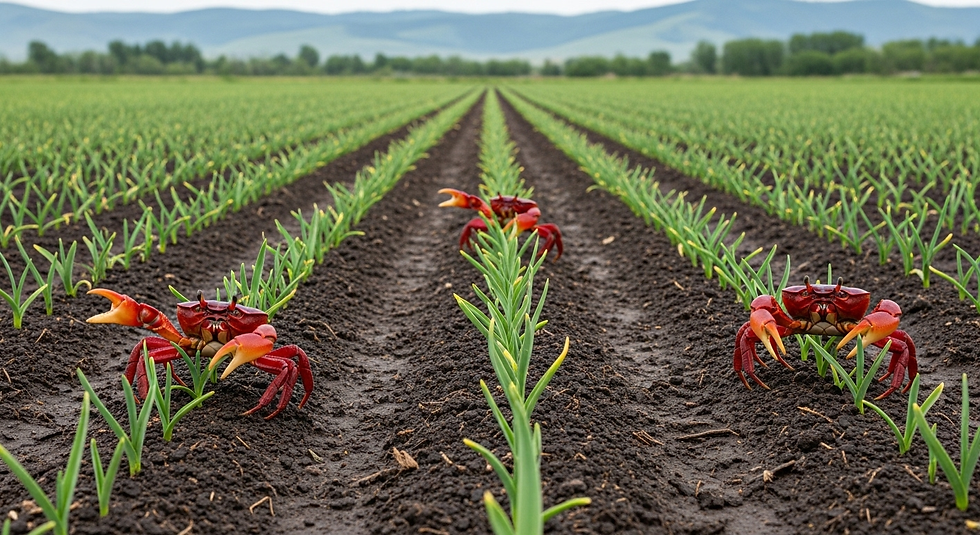Garlic Rust
- Jere Folgert
- Dec 17, 2020
- 3 min read
Garlic Rust: What You Need to Know
Garlic rust is a fungal disease that can affect garlic plants. It is caused by the fungus Puccinia allii, which overwinters on infected plant debris. The fungus produces spores that are spread by wind and rain. These spores can infect garlic plants at any stage of growth, but they are most likely to do so during cool, wet weather.

Why do Garlic Develop Rust?
Garlic plants develop rust due to a fungal infection caused by Puccinia allii. The fungus overwinters on infected plant debris and produces spores that are spread by wind and rain. The spores can infect garlic plants at any stage of growth, but they are most likely to do so during cool, wet weather.
The fungus Puccinia allii is a member of the rust family, which includes over 700 species that can infect a wide range of plants. The fungus has a complex life cycle that involves two different stages of growth. The first stage, known as the uredial stage, occurs on the leaves of the host plant. During this stage, the fungus produces spores that are spread by wind and rain. The second stage, known as the telial stage, occurs on the ground. During this stage, the fungus produces spores that can overwinter and infect new plants the following year.
The symptoms of garlic rust typically appear on the leaves of the plant. The first symptoms are small, yellow or orange spots. These spots eventually enlarge and become raised and powdery. In severe cases, the entire leaf may be covered in rust. The rust can also damage the garlic bulbs, making them smaller and less flavorful.
There are a number of ways to control garlic rust. Some of these methods include:
Sanitation: Remove and destroy any infected plant debris.
Rotate crops: Do not plant garlic in the same location two years in a row.
Use resistant varieties: There are a number of garlic varieties that are resistant to garlic rust.
Apply fungicides: Fungicides can be effective in controlling garlic rust, but they should be used only as a last resort.
The best way to prevent garlic rust is to take steps to avoid the conditions that favor its growth. These include:
Plant garlic in a sunny location with good air circulation.
Avoid planting garlic in cool, wet weather.
Water the soil deeply and regularly, but avoid overhead watering.
Remove and destroy any infected plant debris.
Symptoms of Garlic Rust
The first symptoms of garlic rust are small, yellow or orange spots on the leaves. These spots eventually enlarge and become raised and powdery. In severe cases, the entire leaf may be covered in rust. The rust can also damage the garlic bulbs, making them smaller and less flavorful.
How to Control Garlic Rust
There are a number of ways to control garlic rust. Some of these methods include:
Sanitation: Remove and destroy any infected plant debris.
Rotate crops: Do not plant garlic in the same location two years in a row.
Plant resistant varieties: There are a number of garlic varieties that are resistant to garlic rust.
Apply fungicides: Fungicides can be effective in controlling garlic rust, but they should be used only as a last resort.
Preventing Garlic Rust
The best way to prevent garlic rust is to take steps to avoid the conditions that favor its growth. These include:
Plant garlic in a sunny location with good air circulation.
Avoid planting garlic in cool, wet weather.
Water the soil deeply and regularly, but avoid overhead watering.
Remove and destroy any infected plant debris.
Conclusion
Garlic rust is a serious disease that can damage garlic plants. However, there are a number of ways to control and prevent this disease. By following the tips in this blog post, you can help to protect your garlic plants from garlic rust.
Here are some additional tips for preventing garlic rust:
Choose a resistant variety of garlic.
Plant garlic in a sunny location with good air circulation.
Avoid planting garlic in cool, wet weather.
Water the soil deeply and regularly, but avoid overhead watering.
Remove and destroy any infected plant debris.
Inspect your garlic plants regularly for signs of rust.
If you see any signs of rust, take action immediately to control the disease.


